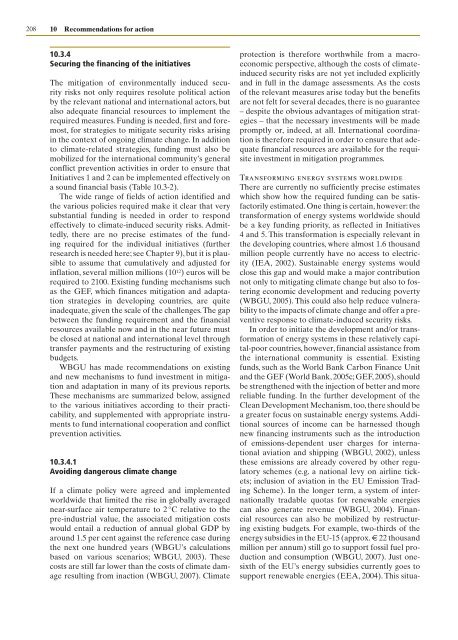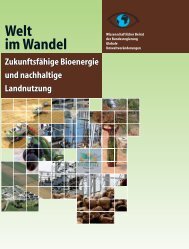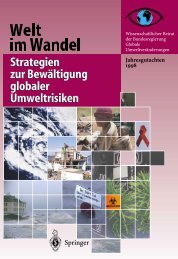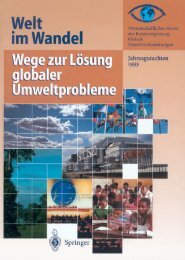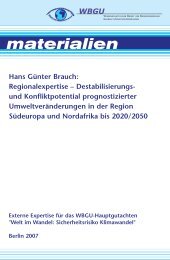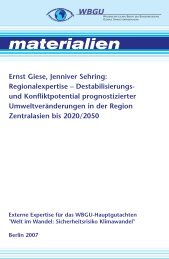World in Transition: Climate Change as a Security Risk - WBGU
World in Transition: Climate Change as a Security Risk - WBGU
World in Transition: Climate Change as a Security Risk - WBGU
You also want an ePaper? Increase the reach of your titles
YUMPU automatically turns print PDFs into web optimized ePapers that Google loves.
208 10 Recommendations for action<br />
10.3.4<br />
Secur<strong>in</strong>g the f<strong>in</strong>anc<strong>in</strong>g of the <strong>in</strong>itiatives<br />
The mitigation of environmentally <strong>in</strong>duced security<br />
risks not only requires resolute political action<br />
by the relevant national and <strong>in</strong>ternational actors, but<br />
also adequate f<strong>in</strong>ancial resources to implement the<br />
required me<strong>as</strong>ures. Fund<strong>in</strong>g is needed, first and foremost,<br />
for strategies to mitigate security risks aris<strong>in</strong>g<br />
<strong>in</strong> the context of ongo<strong>in</strong>g climate change. In addition<br />
to climate-related strategies, fund<strong>in</strong>g must also be<br />
mobilized for the <strong>in</strong>ternational community’s general<br />
conflict prevention activities <strong>in</strong> order to ensure that<br />
Initiatives 1 and 2 can be implemented effectively on<br />
a sound f<strong>in</strong>ancial b<strong>as</strong>is (Table 10.3-2).<br />
The wide range of fields of action identified and<br />
the various policies required make it clear that very<br />
substantial fund<strong>in</strong>g is needed <strong>in</strong> order to respond<br />
effectively to climate-<strong>in</strong>duced security risks. Admittedly,<br />
there are no precise estimates of the fund<strong>in</strong>g<br />
required for the <strong>in</strong>dividual <strong>in</strong>itiatives (further<br />
research is needed here; see Chapter 9), but it is plausible<br />
to <strong>as</strong>sume that cumulatively and adjusted for<br />
<strong>in</strong>flation, several million millions (10 12 ) euros will be<br />
required to 2100. Exist<strong>in</strong>g fund<strong>in</strong>g mechanisms such<br />
<strong>as</strong> the GEF, which f<strong>in</strong>ances mitigation and adaptation<br />
strategies <strong>in</strong> develop<strong>in</strong>g countries, are quite<br />
<strong>in</strong>adequate, given the scale of the challenges. The gap<br />
between the fund<strong>in</strong>g requirement and the f<strong>in</strong>ancial<br />
resources available now and <strong>in</strong> the near future must<br />
be closed at national and <strong>in</strong>ternational level through<br />
transfer payments and the restructur<strong>in</strong>g of exist<strong>in</strong>g<br />
budgets.<br />
<strong>WBGU</strong> h<strong>as</strong> made recommendations on exist<strong>in</strong>g<br />
and new mechanisms to fund <strong>in</strong>vestment <strong>in</strong> mitigation<br />
and adaptation <strong>in</strong> many of its previous reports.<br />
These mechanisms are summarized below, <strong>as</strong>signed<br />
to the various <strong>in</strong>itiatives accord<strong>in</strong>g to their practicability,<br />
and supplemented with appropriate <strong>in</strong>struments<br />
to fund <strong>in</strong>ternational cooperation and conflict<br />
prevention activities.<br />
10.3.4.1<br />
Avoid<strong>in</strong>g dangerous climate change<br />
If a climate policy were agreed and implemented<br />
worldwide that limited the rise <strong>in</strong> globally averaged<br />
near-surface air temperature to 2 °C relative to the<br />
pre-<strong>in</strong>dustrial value, the <strong>as</strong>sociated mitigation costs<br />
would entail a reduction of annual global GDP by<br />
around 1.5 per cent aga<strong>in</strong>st the reference c<strong>as</strong>e dur<strong>in</strong>g<br />
the next one hundred years (<strong>WBGU</strong>’s calculations<br />
b<strong>as</strong>ed on various scenarios; <strong>WBGU</strong>, 2003). These<br />
costs are still far lower than the costs of climate damage<br />
result<strong>in</strong>g from <strong>in</strong>action (<strong>WBGU</strong>, 2007). <strong>Climate</strong><br />
protection is therefore worthwhile from a macroeconomic<br />
perspective, although the costs of climate<strong>in</strong>duced<br />
security risks are not yet <strong>in</strong>cluded explicitly<br />
and <strong>in</strong> full <strong>in</strong> the damage <strong>as</strong>sessments. As the costs<br />
of the relevant me<strong>as</strong>ures arise today but the benefits<br />
are not felt for several decades, there is no guarantee<br />
– despite the obvious advantages of mitigation strategies<br />
– that the necessary <strong>in</strong>vestments will be made<br />
promptly or, <strong>in</strong>deed, at all. International coord<strong>in</strong>ation<br />
is therefore required <strong>in</strong> order to ensure that adequate<br />
f<strong>in</strong>ancial resources are available for the requisite<br />
<strong>in</strong>vestment <strong>in</strong> mitigation programmes.<br />
Transform<strong>in</strong>g energy systems worldwide<br />
There are currently no sufficiently precise estimates<br />
which show how the required fund<strong>in</strong>g can be satisfactorily<br />
estimated. One th<strong>in</strong>g is certa<strong>in</strong>, however: the<br />
transformation of energy systems worldwide should<br />
be a key fund<strong>in</strong>g priority, <strong>as</strong> reflected <strong>in</strong> Initiatives<br />
4 and 5. This transformation is especially relevant <strong>in</strong><br />
the develop<strong>in</strong>g countries, where almost 1.6 thousand<br />
million people currently have no access to electricity<br />
(IEA, 2002). Susta<strong>in</strong>able energy systems would<br />
close this gap and would make a major contribution<br />
not only to mitigat<strong>in</strong>g climate change but also to foster<strong>in</strong>g<br />
economic development and reduc<strong>in</strong>g poverty<br />
(<strong>WBGU</strong>, 2005). This could also help reduce vulnerability<br />
to the impacts of climate change and offer a preventive<br />
response to climate-<strong>in</strong>duced security risks.<br />
In order to <strong>in</strong>itiate the development and/or transformation<br />
of energy systems <strong>in</strong> these relatively capital-poor<br />
countries, however, f<strong>in</strong>ancial <strong>as</strong>sistance from<br />
the <strong>in</strong>ternational community is essential. Exist<strong>in</strong>g<br />
funds, such <strong>as</strong> the <strong>World</strong> Bank Carbon F<strong>in</strong>ance Unit<br />
and the GEF (<strong>World</strong> Bank, 2005c; GEF, 2005), should<br />
be strengthened with the <strong>in</strong>jection of better and more<br />
reliable fund<strong>in</strong>g. In the further development of the<br />
Clean Development Mechanism, too, there should be<br />
a greater focus on susta<strong>in</strong>able energy systems. Additional<br />
sources of <strong>in</strong>come can be harnessed though<br />
new f<strong>in</strong>anc<strong>in</strong>g <strong>in</strong>struments such <strong>as</strong> the <strong>in</strong>troduction<br />
of emissions-dependent user charges for <strong>in</strong>ternational<br />
aviation and shipp<strong>in</strong>g (<strong>WBGU</strong>, 2002), unless<br />
these emissions are already covered by other regulatory<br />
schemes (e.g. a national levy on airl<strong>in</strong>e tickets;<br />
<strong>in</strong>clusion of aviation <strong>in</strong> the EU Emission Trad<strong>in</strong>g<br />
Scheme). In the longer term, a system of <strong>in</strong>ternationally<br />
tradable quot<strong>as</strong> for renewable energies<br />
can also generate revenue (<strong>WBGU</strong>, 2004). F<strong>in</strong>ancial<br />
resources can also be mobilized by restructur<strong>in</strong>g<br />
exist<strong>in</strong>g budgets. For example, two-thirds of the<br />
energy subsidies <strong>in</strong> the EU-15 (approx. € 22 thousand<br />
million per annum) still go to support fossil fuel production<br />
and consumption (<strong>WBGU</strong>, 2007). Just onesixth<br />
of the EU’s energy subsidies currently goes to<br />
support renewable energies (EEA, 2004). This situa-


